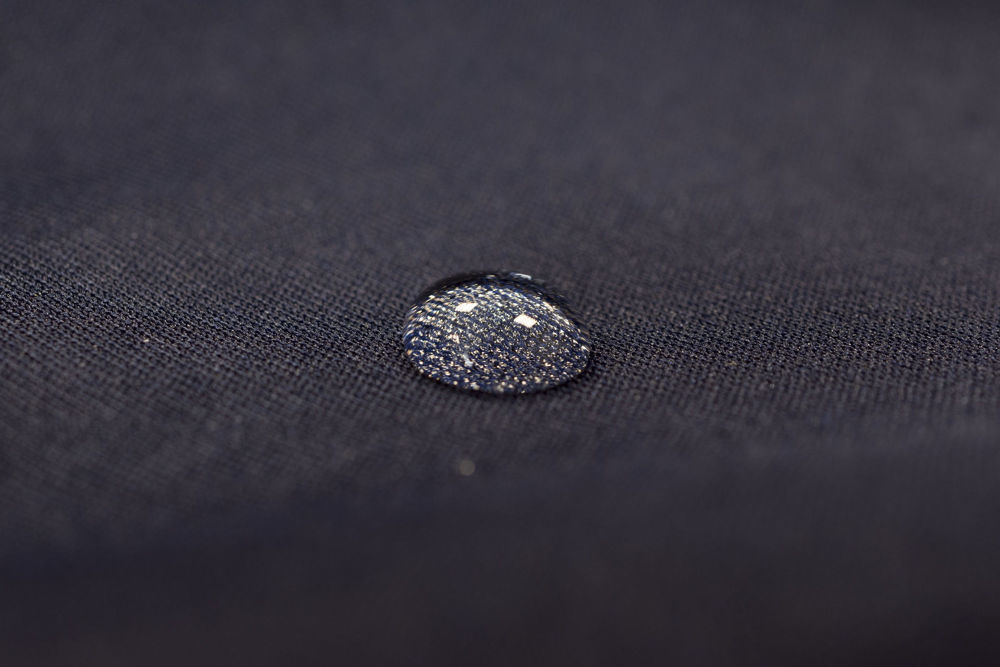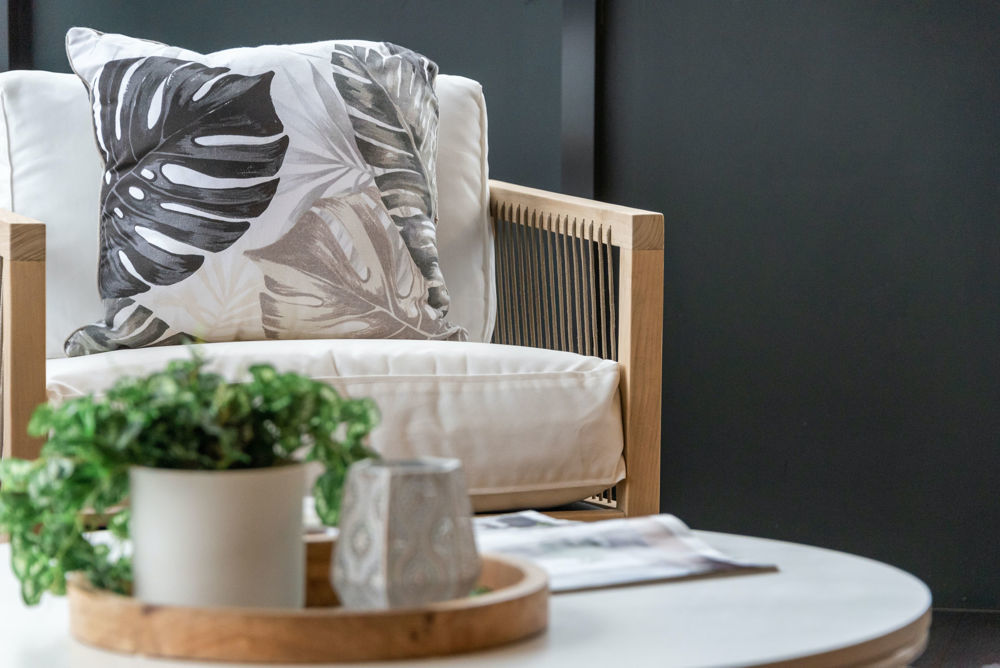
In the UK, it can seem like a very rare occasion when we can get out in the nice weather and enjoy our outdoor spaces, so when we get the opportunity we want to make the most of it. On the rare occasions we can get our outdoor fabric cushions, parasols and canopies out, the last thing we want is for these to get wet in a sudden shower or become stained and looking less than their best. Ever wondered whether you can protect these fabrics? Well, you are in luck as we have put together our guide that covers everything you need to know about waterproofing outdoor fabric, so you never have to worry about the weather again.
Why Waterproof Outdoor Fabric?
When it comes to any exterior surface, whether it be masonry, roof tiles, wood or fabric, water and moisture is its biggest enemy. Moisture leads to a number of problems not only with the appearance of these surfaces, but their performance.
Constant wetting of fabric can lead to streaks and stains, while also allowing mould and other fungal growth to develop thanks to it providing the high levels of moisture that fungus requires in order to grow. This moisture can not only get into fabric cushions and other outdoor fabric from rainfall, but also through drink spillages, causing the fabric to absorb and ultimately hold moisture.
Is Any Outdoor Fabric Waterproof?
Exterior fabric can vary widely, with some designed to allow water to travel straight through the material to avoid it becoming saturated with water, while others have very little resistance to moisture. It is important to bear in mind that there are a number of terms that refer to a fabrics ability to stay dry. If a product refers to itself as 'water resistant', this likely means that it is designed to allow water to enter the fabric and then naturally breathe out over-time. A 'water repellent' product repels water completely once it hits the surface of the fabric, meaning the water cannot enter the fabric and therefore ensures the surface remains dry.
You may be wondering, 'how can I tell if my fabric is waterproof'? The chances are if you have fabric that isn't specifically designed for outdoor use, such as cushions, these will not have any waterproofing properties. If a product is specifically designed for outdoor use, depending on the quality of the fabric, these could already have waterproof properties. Expensive outdoor furniture can sometimes come with water repellent fabric or PVC backing stitched into the inside of the surface, ensuring the fabric stays protected. Lower cost fabric cushions, parasols and seating may not be made with any water repellent properties and simply designed to allow the moisture to escape back out of the surface.
The best way to see whether your fabric needs waterproofing is by dropping a little bit of water on to it from a height. If the water 'beads' on the surface and does not soak into the fabric, this means it is already water repellent and should not need waterproofing. If the water absorbs into the fabric and darkens the surface, this is an indicator that it is able to get wet if it was left in rainfall and therefore needs waterproofing if you want to keep them dry.

How Do You Waterproof Outdoor Fabric?
If you have established that your fabric surfaces that you intend to use outside are not waterproof, you can add waterproofing properties to the fabric by applying a fabric waterproofer.
There are a number of waterproofing products designed for fabric, however these are all designed in different ways. Many waterproofing treatments are designed to be effective for 1-2 weeks before being re-applied as they will eventually weather off the surface of the fabric. Furthermore, some products can have low breathability, which traps moisture within the cushion, leading to mould and mildew.
For these reasons Emperor Exterior Fabric Waterproofer was developed, which contains the same highly advanced nano-technology as Emperor Paint products for exterior masonry & wood. The nano-technology chemically bonds to the fabric, creating what is known as a super hydrophobic (ultra water repellent) surface of the fabric. This chemical bonding means it does not change the appearance of the fabric in any way and means it does not wear off the surface of the fabric, allowing it to perform long-term without re-application. The waterproofer does not impact the breathability of the fabric, as it lines the pores of the fabric, meaning while water in liquid form is too large to pass through the pores, water vapour can still naturally pass through the fabric and ensure full breathability.
The outdoor fabric waterproofer also has anti-stain properties, as just like water, dirt and other contamination cannot attach to the treated fabric. The formulation is water-based, meaning it is environmentally friendly and does not have any nasty odours that can linger on the fabric.

Before you apply anything to the fabric, ensure it is clean and dry. Any moisture in the fabric can impact how the product dries and thus how it will perform moving forward. If there is any dirt on the surface this will impact the treatment in a number of ways. Firstly, it could prevent this treatment adhering to the fabric. Secondly, as the treatment is invisible, any dirt or staining will be clear to see and will be difficult to remove once treated. Some fabrics can be machine washed, which is recommended if they have a larger amount of discolouration on them. Make sure you check the label of the fabric to see what the manufacturer recommends for cleaning.
When applying a waterproofing product to any surface, it is important to do a test first to see how the fabric and the product reacts. Not all fabric is made the same, with thousands of different variations, so test a small, discrete area first.
Place the fabric on to some cardboard or a dust sheet to avoid applying the treatment to the floor. The treatment comes in a spray bottle so can be applied quickly and easily to the fabric with no clean-up of any tools required. The treatment can cover anywhere from 8-15m2 per litre depending on the fabric and how porous it is. Simply spray the treatment at roughly 6 inches from the surface. You will see the treatment darken the fabric, allowing you to see exactly where you have treated and identify if any areas have more applied than others.
Once you have applied to the treatment to the fabric, allow it to dry for 1-2 hours. If you are treating cushions, you can then flip over the cushion and treat the other side, only once the first side is fully dry.
After the treatment has dried, you will be able to see water 'bead' on the surface, causing it to simply fall off the fabric before it absorbs in.
Frequently Asked Questions
Q. HOW DOES EMPEROR FABRIC WATERPROOFER PREVENT STAINS?
There are two ways that the super hydrophobic technology in Emperor Exterior Fabric Waterproofer prevents stains. Firstly, by preventing water absorption, any discolouration and marking from rainfall is prevented, which ordinarily can lead to streaks appearing on the fabric. Secondly, the super hydrophobic surface that is created makes it very difficult for dirt and other contaminants to attach to the treated fabric, meaning you do not get any deep, ingrained stains or marks that fabric is often prone to.
Q. CAN A WATERPROOFING SPRAY DAMAGE FABRIC?
Not all waterproofing sprays are made the same, so it is important to check with the manufacturer of the product to see if they recommend the product for a particular use. Emperor Exterior Fabric Waterproofer due to the way it uses nano-technology to chemically bond does not modify or change the fabric in any way other than providing it will water repellent properties. The water-based formulation does not contain any toxic substances and will not create a film on the surface of the fabric, like a wax or coating.
Q. CAN A WATERPROOFING SPRAY EXTEND THE LIFESPAN OF FABRIC?
Absolutely, by preventing water from getting into the fabric, a waterproofing spray will extend the lifespan of any fabric. While some more expensive outdoor fabric furniture can come with a 10 year lifespan, many other fabrics will only last a couple of years when regularly exposed to weathering. Keeping the fabric dry, clean and free from mould is going to ensure that the fabric stays performing and looking its best for as long as possible.
Q. WHAT SHOULD I DO TO DRY OUT FABRIC BEFORE TREATMENT?
If you have some fabric cushions, for example, that you need to dry out ready for treatment, the best thing to do is get them inside to avoid any further water absorption. If there is no way to get them drying outside, put them near a source of heat such as a radiator. If you can, put them on a washing line in the sun, which will help them release some of that deep ingrained moisture. The high breathability of Emperor Exterior Fabric Waterproofer means that any moisture in the cushions will be able to breathe out after treatment, but it is still important to ensure they are dry as possible to allow the treatment to do its job.

We hope we have answered any questions you may have had regarding waterproofing outdoor fabric in order to keep your cushions, parasols & canopies dry. If you have any other questions, feel free to get in touch with our team of experts who are on hand to assist you. Contact them today by emailing info@emperorpaint.co.uk or calling 0161 509 9009. Alternatively, shop our range of exterior waterproofing treatments today and get free next working day delivery on all orders over £50.

